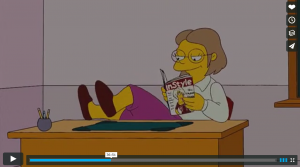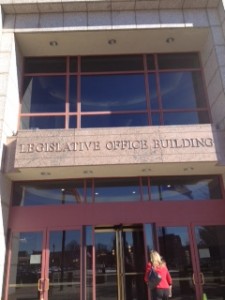Title IX is a law that was an annex to the Education Amendment Rights of 1972 that requires gender equity for males and females. Essentially, the law states that all students of any sex, male or female, have the right to access every educational program that receives funds from the Federal government. Title IX is usually perceived as a law that applies to sports, however, sports are only one of the ten areas that is addressed in this law. Title IX and what it stands for has changed significantly over time. Among many college campuses, when Title IX is heard of, many people connect the law to having a focus on gender equality in sports and now has a strong focus on sexual harassment. The focus on sexual harassment has grown immensely on college campuses. For example, campuses such as Trinity College, located in Hartford, Connecticut, requires that all incoming students watch a Title IX video which has a main focus on sexual harassment on the college campus. Initially, the supporters and political advocates of Title IX focused on the demand for gender equality in education and the workplace and was purposely created to end sexual discrimination in education and the work place. Has Title IX eliminated gender inequality? How did researchers and political advocates argue in favor of Title IX prior to its passing in 1972 and after its passing?
It is clear that political advocates and researchers have held the goals of Title IX that was proposed prior to its passing in 1972. However, Title IX has had central focuses at different points in time. To some, Title IX has had a central focus on having women being able to play sports in higher education institutions. Recently, Title IX has had a major focus on sexual harassment on college campuses and in employment institutions. Title IX and its creation comes from one of its main supporters and political advocates, Edith Green, also known as the mother of Title IX. Green is known as the political advocate who proposed Title IX and the crafter of Title IX. A former teacher and a former staff member for the Oregon Education Association (Phi Delta Kappa International Vol. 29, 1968) Green used her power to establish the Title IX bill. Her aim, was to make federally funded higher education institutions open to women and men. Along with that she advocated for equal pay for both male and female employers. For Green, she had a view of better education for students in educational institutions at all levels, including, elementary, secondary, and those in higher education institutions. Her mindset sets the preface to Title IX. Green believed that students at all education levels who live in poverty or those who do not have the access to extracurricular activities outside of school should have the opportunity to have a safe place to go. In an interview with congresswoman Edith Green, she stated that she would like to give all students the chance to have a community center and a safe place to be by using the educational institutions when they are not in use (Phi Delta Kappa International Vol. 29, 1968). Because of Green’s personal experience with gender discrimination, this pushed her to advocate for women’s rights at a much more assertive rate. Being a woman in congress surrounded by men, Green experienced consistent discrimination because of her gender. As a female, she outperformed many of the congressmen (Women in Congress, 2015). Green believed that if she was experiencing sexual discrimination at such a high level of power, other employed women may be facing the same discrimination. Green believed, “woman has to work twice as hard as a man to prove that she can do the job” and because of this she worked to draft a legislation that would give women equal rights and opportunities as men (Women in Congress, 2015). Two of her main goals while being a representative, was to achieve pay equity and gender equality in higher education institutions and the work environment through Title IX.
Two other political advocates who had strong opinions as to why Title IX should be passed was Birch Bayh and Patsy T. Mink. Birch Bayh, a Senator at the time of Title IX passing, was called the “father of Title IX (American Civil Liberties Union, 2016). Patsy T. Mink, the representative of Hawaii is seen as an author and major sponsor of Title Ix and its passing. Both Mink and Bayh held similar arguments and advocated strongly as to why Title IX needed to be passed into law. According to Diane Henson in Litigation states that both Mink and Bayh advocated that “Title IX had the ambitious purpose of ending sexual stereotypes in society and providing equal opportunity for women in education. Scholarships, graduate assistantships, professional salaries—all would be affected” (Litigation, 2005). These two individuals held a great power in government that allowed them to pose viable arguments as to why Title IX should be passed into law. Not only was Mink and Bayh able to have this law passed, but with it, Congress intended that there would also be an increase in the various employment opportunities for women to be enhanced. These advocates received corporation from many secondary and post-secondary institutions because many of them feared that their federal funding would be cut if they did not abide by the new law. Title IX served as a powerful weapon to conquer sexual discrimination and possibly end sexual discrimination in places of employment and in educational institutions. For Representative Patsy T. Mink, she based her support for Title IX on the fact that she faced multiple forms of sexual discrimination in her time spent in educational institutions. Mink states that during her time spent on the United States Congress, she continuously battled gender discrimination and racism from the very start of her career. During the years in which she applied to medical school, she was denied by twelve schools which she was believed was due to her being a female. She continued to face gender discrimination when she decided to apply to law school and was rejected because she was a married woman. For Mink, sports became one of the reasons why she advocated for Title IX. In her years in secondary education, she was never allowed to play full court basketball because it was believed that females playing a full court game of basketball was too difficult. As stated by Mink, “…many inequities in our schools continue to prevent girls from reaching their full academic, social, and economic potential” (The Girl’s Crisis Movement, in General Psychology, 2010) which is why advocating for Title IX was essential in ending gender discrimination that girls face in schools. It is clear that Patsy T. Mink and Edith Green, two women in government who held high positions, both advocated for the gender discrimination against women to end. Because if the experiences that they faced throughout their schooling at the elementary, secondary, and post-secondary education. Mink advocated for women to be accepted into medical schools and to be able to have equal opportunities to play sports. Prior to Title IX, only ten percent of students in medical school were women. After Title IX was passed until 2012, that number has increased to thirty-five percent of women who are now residents in surgery (Carnes, 2012). Although these advocates had multiple reasons as to why Title IX should be passed into law, the way that Title IX is perceived now and what it stands for has changed to some extent.

Ever since the passing of Title IX, advocates and researchers have argued differently about Title IX. For some individuals, when Title IX is mentioned on college campuses, it was first thought of as a way to end gender discrimination in sports and allowing women to receive equal treatment to men. According to advocates of Title IX at Yale, the Yale law journal states, “The movement’s leaders are smart, courageous survivors of gender-based violence—virtually all of whom are current undergraduates or recent college graduates. Joining them are multiple generations of anti-gender-based violence activists, attorneys, leaders, and scholars” (Yale Law Journal, 2015). These student advocates have centered the Title IX law as one that focuses on gender-based violence. The article continues on to state that these individuals are joined by other generations who have begun using and changing the law to end sexual violence in the work environment, by reforming the criminal law of rape, and to empower victims of domestic violence to seek legal aid (Yale Law Journal, 2015). To these advocates in the year 2015 who have made connections to advocates from the 1980’s they have been using Title IX and are seeing it as a gateway to end sexual assaults, and as a gateway for women to speak up about being raped, abused, or threated.
For other advocates of Title IX, the center of their focus is equal treatment for women in sports at the secondary and post-secondary institutions. One advocate of this was a secondary school girls’ basketball coach who felt like his girls’ team was being treated unfairly compared to the boys’ team. Under Title IX, coach Jackson sued his secondary school and won. Jackson’s girls team was being treated unfairly in that they were not allowed to use the new basketball gym for practice, they did not have access to the ice machine for injured players to reduce swelling when hurt and not having the necessary uniforms for the girls (Greenberger et. Al, 2005). A simple search of the term “Title IX” tends to produce multiple court cases that are focused on gender discrimination in sports and various sexual harassment cases. Many advocates have highlighted these two focuses of the law as the main components of Title IX. When visiting the website, “Know Your IX” a list is provided of the IX rights that students should be aware of under the Title IX law. All of these rights are about sexual assault or sexual harassment proving that for many, Title IX is seen as a law main goal is to end sexual assault and harassment.
For other women advocates, they have actually found problems with Title IX and have made multiple complaints. In a summary of issues being raised by women’s groups concerning the proposed regulations of Title IX, these women have composed a list of issues pertaining to particular sections of the regulations. These issues are focused on the education equality aspect of Title IX. One of the complaints in the summary is centered on the admission of part- time and older students. These women find that the law does not have any prohibitions that concern the treatment of part time students. They found that there were restrictions on part time students financial aid and that Title IX needed to address the policies and practices that affect such students. Another concern that these women had was that there was no clear distinction between remedial and Affirmative action in Post-secondary institutions. “The women feel like a clear understanding of the limits and essential contents of remedial and affirmative action is necessary to give guidance concerning Title IX compliance” (Sandler, 1975)
Have the arguments that advocates made prior to the passing of Title IX really changed after it became a law? Some may argue that Title IX went from being a law that covered a diversity of various aspects against gender discrimination on women. Topics such as educational equality, sports equality, opportunity to stray away from the multiple negative stereotypes that women may face, and equality in greater job opportunities for women. It was also passed so that women may receive equal pay to men in the labor force, and to help prevent sexual harassment at educational institutions and at work environments. As the years have progressed, the law has had very key focuses to some advocates and researchers compared to others. To some advocates, Title IX is essential to stopping or reducing sexual assault at various institutions such as college campuses and work areas. To others, Title IX is the law that allows women to be treated fairly in sports, not only at educational institutions but in any federally funded program. According to a Title IX advocate and law professor at Florida Coastal School of Law, Nancy Hogshead-Makar, “Title IX is working every bit as hard in the classroom as it is on the athletic field and the original goal was access to education for girls and women as broadly as you can imagine—as broadly as education goes” (Kilman, 2012). Overall, the passing of Title IX has led to many great improvements in gender discrimination against women. There are more women in medical and science fields and many women have gone on to play sports beyond the post-secondary level. Aside from those components, Title IX has been able to give women a voice and a cushion to fall back on in case they may face difficulties with sexual discrimination at school or work.
Works Cited:
Edith Green: A Congresswoman Discusses the Politics of Education. (1968). Edith Green: A Congresswoman Discusses the Politics of Education. The Phi Delta Kappan, 49(6), 307–311. Retrieved from http://www.jstor.org.ezproxy.trincoll.edu/stable/20372069
Wasniewski, M. A. (2006). Women in Congress, 1917-2006 (No. 14903). Government Printing Office.
Suggs, W. “New developments may alter enforcement of Title IX.” The Chronicle of Higher Education (2005): A33-A34.
Southern Poverty Law Center. 400 Washington Avenue, Montgomery, AL 36104. Tel: 334-956-8200; Fax: 334-956-8484; Web site: http://www.tolerance.org/teach/magazine/index.jsp
Title IX – The Nine. (n.d.). Retrieved April 21, 2016, from https://www.aclu.org/title-ix-nine
Henson, D. (2005). From Pom-Pom Girls to Center Court. Litigation, 31(4), 30–34. Retrieved from http://www.jstor.org.ezproxy.trincoll.edu/stable/29760514
2011 Womens Sports foundation. http://www.womenssportsfoundation.org/home/she-network/education/patsy-mink
Farady, M. (2010). The girl-crisis movement: Evaluating the foundation. Review Of General Psychology, 14(1), 44-55. doi:10.1037/a0019024
Carnes, M. (2012). What would Patsy Mink think?. JAMA: Journal Of The American Medical Association, 307(6), 571-572. doi:10.1001/jama.2012.79
Nancy Chi Cantalupo, For the Title IX Civil Rights Movement: Congratulations and Cautions, 125 YALE L.J. F. 281 (2016), http://www.yalelawjournal.org/forum/for-the-title-ix-civil-rights-movement-congratulations-and-cautions
Greenberger, M. D., & Chaudhry, N. K.. (2005). Sex Discrimination in Education: Miles to Go Before We Sleep. Human Rights, 32(4), 19–21. Retrieved from http://www.jstor.org.ezproxy.trincoll.edu/stable/27880503
Greenberger, M. D., & Chaudhry, N. K.. (2005). Sex Discrimination in Education: Miles to Go Before We Sleep. Human Rights, 32(4), 19–21. Retrieved from http://www.jstor.org.ezproxy.trincoll.edu/stable/27880503
Sandler, B., Dunkle, M. C., Gleaves, F., Meckes-Jones, K., & Hunter, L.. (1974). Summary of Issues Being Raised by Women’s Groups concerning the Proposed Regulations for Title IX of the Education Amendments of 1972. Women’s Studies Newsletter, 2/3(4/1), 13–17. Retrieved from http://www.jstor.org/stable/40042356
Kilman. C.(2012). Southern Poverty Center: Title IX at 40. http://www.tolerance.org/magazine/number-42-fall-2012/feature/title-ix-40.
Title IX at 40. (n.d.). Retrieved April 21, 2016, from http://www.tolerance.org/magazine/number-42-fall-2012/feature/title-ix-40







